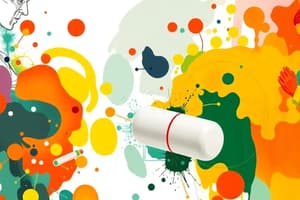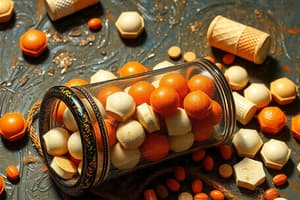Podcast
Questions and Answers
What is an excipient?
What is an excipient?
A pharmacologically inactive substance formulated alongside the active pharmaceutical ingredient (API) of a medication.
Which of the following is NOT a purpose served by excipients?
Which of the following is NOT a purpose served by excipients?
- Aid in handling of API during manufacturing
- Facilitate drug absorption or solubility
- Directly treat the medical condition (correct)
- Provide bulk to the formulation
An ideal excipient should have unwished interactions with the drug.
An ideal excipient should have unwished interactions with the drug.
False (B)
Match the excipient with its property:
Match the excipient with its property:
Which of the following is a typical feature of fillers?
Which of the following is a typical feature of fillers?
Which of the following is an example of a filler used in pharmaceutical formulations?
Which of the following is an example of a filler used in pharmaceutical formulations?
What is the purpose of binders in tablets?
What is the purpose of binders in tablets?
Which of the following is an example of a dry binder?
Which of the following is an example of a dry binder?
What is the function of disintegrants in drug formulations?
What is the function of disintegrants in drug formulations?
Which of the following is an ideal property of disintegrants?
Which of the following is an ideal property of disintegrants?
Which of the following is a type of coating agent used pharmaceutically?
Which of the following is a type of coating agent used pharmaceutically?
Write one function of coating agents:
Write one function of coating agents:
What are sorbents?
What are sorbents?
Which of the following is a synthetic sorbent?
Which of the following is a synthetic sorbent?
What do anti-adherents prevent?
What do anti-adherents prevent?
Which of these is an example of an anti-adherent?
Which of these is an example of an anti-adherent?
What is the primary function of lubricants in pharmaceutical manufacturing?
What is the primary function of lubricants in pharmaceutical manufacturing?
Whihc of these is a type of lubricant?
Whihc of these is a type of lubricant?
What is the role of glidants in pharmaceutical formulations?
What is the role of glidants in pharmaceutical formulations?
Which of the following is an example of a glidant?
Which of the following is an example of a glidant?
What is the main purpose of preservatives in pharmaceutical products?
What is the main purpose of preservatives in pharmaceutical products?
Preservatives must exert a wide spectrum of antimicrobial activity at [blank] inclusion levels.
Preservatives must exert a wide spectrum of antimicrobial activity at [blank] inclusion levels.
Define antioxidants.
Define antioxidants.
Antioxidants should be effective only at high, toxic concentrations.
Antioxidants should be effective only at high, toxic concentrations.
What is the main purpose of sweetening agents in liquid formulations?
What is the main purpose of sweetening agents in liquid formulations?
Examples of sweetening agents include:
Examples of sweetening agents include:
Why are flavoring agents added to pharmaceutical formulations?
Why are flavoring agents added to pharmaceutical formulations?
What is one of the four basic taste sensations?
What is one of the four basic taste sensations?
What are coloring agents used for in pharmaceutical formulations?
What are coloring agents used for in pharmaceutical formulations?
The text lists two types of coloring agents
The text lists two types of coloring agents
Flashcards
Excipient
Excipient
Pharmacologically inactive substance formulated alongside the active pharmaceutical ingredient (API) of a medication.
Purposes of Excipients
Purposes of Excipients
Provide bulk, facilitate drug absorption/solubility, aid in handling during manufacturing, and provide stability.
Key Excipient Properties
Key Excipient Properties
Inactive and doesn't interact with the drug.
Types of Pharmaceutical Excipients
Types of Pharmaceutical Excipients
Signup and view all the flashcards
Function of Fillers
Function of Fillers
Signup and view all the flashcards
Typical Features of Fillers
Typical Features of Fillers
Signup and view all the flashcards
Examples of Fillers
Examples of Fillers
Signup and view all the flashcards
Function of Binders
Function of Binders
Signup and view all the flashcards
Typical Features of Binders
Typical Features of Binders
Signup and view all the flashcards
Classification of Binders
Classification of Binders
Signup and view all the flashcards
Examples of Binders
Examples of Binders
Signup and view all the flashcards
Disintegrants
Disintegrants
Signup and view all the flashcards
Ideal Properties of Disintegrants
Ideal Properties of Disintegrants
Signup and view all the flashcards
Examples of Disintegrants
Examples of Disintegrants
Signup and view all the flashcards
Coating
Coating
Signup and view all the flashcards
Types of Coating
Types of Coating
Signup and view all the flashcards
Function of Coating Agents
Function of Coating Agents
Signup and view all the flashcards
Sorbents
Sorbents
Signup and view all the flashcards
Types of Sorbents
Types of Sorbents
Signup and view all the flashcards
Functions of Sorbents
Functions of Sorbents
Signup and view all the flashcards
Anti-Adherents
Anti-Adherents
Signup and view all the flashcards
Examples of Anti-Adherents
Examples of Anti-Adherents
Signup and view all the flashcards
Lubricants
Lubricants
Signup and view all the flashcards
Types of Lubricants
Types of Lubricants
Signup and view all the flashcards
Roles of Lubricants
Roles of Lubricants
Signup and view all the flashcards
Examples of Lubricants
Examples of Lubricants
Signup and view all the flashcards
Glidants
Glidants
Signup and view all the flashcards
Functions of Glidants
Functions of Glidants
Signup and view all the flashcards
Examples of Glidants
Examples of Glidants
Signup and view all the flashcards
Preservatives
Preservatives
Signup and view all the flashcards
Study Notes
- Pharmaceutical excipients are substances formulated alongside the active pharmaceutical ingredient (API) in medications.
- Excipients are pharmacologically inactive.
Purposes of Excipients
- Provide bulk to the formulation.
- Facilitate drug absorption/solubility and other pharmacokinetic considerations.
- Aid in handling of the API during manufacturing.
- Provide stability and prevent denaturation.
Ideal Excipient Properties
- Stable and reproducible
- No unwanted interaction with the drug
- Pharmacologically inert
- Has desired functionality
- Cost-effective
Types of Pharmaceutical Excipients
- Fillers
- Binders
- Coating Agents
- Anti-adherents
- Preservatives
- Antioxidants
- Flavouring Agents
- Colouring Agents
- Sweetening Agents
- Disintegrants
- Sorbents
- Glidants
- Lubricants
Fillers
- Fillers increase the size of a tablet or capsule.
- This increase in size makes production practical and use convenient.
- Fillers add volume and/or mass to a drug substance for precise metering and handling.
- Fillers are used in tablets and capsules.
- A good filler is inert, compatible with other components, non-hygroscopic, cheap, compactable, tasteless or pleasant tasting.
- Examples of fillers are plant cellulose, dibasic calcium phosphate, lactose, mannitol, sorbitol, calcium carbonate, and magnesium stearate.
- Vegetable fats and oils are used in soft gelatine capsules.
Binders
- Binders hold the ingredients in a tablet together.
- Binders ensure tablets & granules have the mechanical strength and give volume to low active dose tablets.
- A binder is compatible with other constituents, and add cohesion to powders.
Classification of Binders by Application
- Solution binders are dissolved in a solvent, such as water or alcohol.
- Dry binders are added to powder, like cellulose, methyl cellulose, polyvinyl pyrrolidone, and polyethylene glycol.
Disintegrants
- Disintegrants are substances or mixtures added to drug formulations.
- Disintegrants facilitate dispersion or breakup of tablets and capsule contents into smaller particles for quick dissolution upon contact with water in the GIT.
- Disintegrants should have good hydration capacity
- Disintegrants should have poor solubility and gel formation capacity.
- Examples of disintegrants include polyvinylpyrrolidone, carboxymethyl cellulose, and sodium starch glycolate.
Coating Agents
- Coating is a process where a dry, outer layer of coating material is applied to the surface of a dosage form.
- Coating agents are what is used in the coating process.
- Three types of coating agents used pharmaceutically are film coating, sugar coating, and compressions coating.
- Coating agents provide protection, masking, elegance, ease of swallowing, and identification.
Sorbents
- Sorbents soak up oil from water
- Natural sorbents include peat moss, sawdust, feathers, and anything else natural containing carbon.
- Synthetic sorbents include polyethylene and nylon.
- Sorbents are used for tablet/capsule moisture-proofing by limiting fluid.
Anti-adherents
- Anti-sticking keeps the surface of the tablet sticking to the die walls and the punches.
- Water-insoluble lubricants (magnesium stearate, talc & starch) are used as anti-adherents.
Lubricants
- Lubricants prevent ingredients from clumping together and from sticking to tablet punches or capsule filling machines.
- Lubricants make sure that tablets are formed and ejected with little friction between the solid substance and the die wall.
Types of Lubricants
- Hydrophilic lubricants are poor lubricants with no glidant or anti-adherent properties.
- Hydrophobic lubricants are the most widely used and effective at low concentrations.
- Hydrophobic lubricants also have anti-adherent and glidant properties.
- Magnesium stearate is an example.
Roles of Lubricants
- True Lubricant Role: Decrease friction between the tablet surface & die wall during ejection and reduce wear on punches.
- Anti-adherent Role: Prevent sticking to punch faces or in encapsulation.
- Glidant Role: Enhance product flow by reducing interparticle friction.
- Polyethylene glycol, magnesium stearate, and stearic acid/derivatives are lubricant examples.
Glidants
- Glidants are substances like colloidal silica that enhance flow of a granular mixture.
- Glidants reduce inter-particle friction & are used in pharmaceutical production of tablets & capsules.
- Glidants are used to promote powder flow reducing interparticle friction & cohesion.
- Glidants are used with lubricants, since Glidants don't reduce die wall friction.
- Fumed silica, talc, & magnesium carbonate are examples.
Preservatives
- Added to various food and pharmaceutical products to prolong shelf life.
- Preservative systems protect the product against microbial proliferation without compromising product performance.
- Preservatives must exert a wide spectrum of antimicrobial activity at low inclusion levels.
- Preservatives must maintain activity throughout product manufacture, shelf life, and usage.
- Preservatives should not compromise product quality, performance, pack, or delivery system.
- Preservatives should not adversely affect patient safety or tolerance of product.
- Examples are methyl & ethyl parabens, propyl paraben, benzoic acid & its salts, and sorbic acid and its salts.
Antioxidants
- Antioxidants are molecules inhibiting the oxidation of other molecules by transfering electrons or hydrogen from a substance to an oxidizing agent.
- Antioxidants must be effective at a low, nontoxic concentration level.
Ideal Properties of Antioxidants
- Stable and effective under normal conditions of use, over a wide pH and temperature range.
- Soluble at the needed concentration.
- Compatible with drugs and pharmaceutical excipients.
- Free from objectionable odor and taste.
- Colorless in both original and oxidized form.
- Non-toxic both internally & externally at the required conc.
- Unreactive (does not adsorb, penetrate, or interact) with containers or closures.
- Antioxidants should be cost-effective
- BHT (Butylated Hydroxy Toluene), BHA (Butyl Hyd Anisol), and sodium sulfite are examples.
Sweetening Agents
- Sweetening agents are used in liquid formulations to increase palatability of the therapeutic agent.
- Sucrose, saccharine, aspartame, and sorbitol are examples.
- The main agents used in oral preparations are sucrose, liquid glucose, glycerol, sorbitol, saccharin sodium & aspartame.
- Aspartame is an artificial sweetening agent.
- Use of sugars in oral formulations for children and patients with diabetes mellitus must be avoided.
Flavoring Agents
- Flavoring agents are added to increase patient acceptance.
- The four basic taste sensations are salty, sweet, bitter, and sour.
- Certain flavors are used to mask these specific taste sensations.
- Clove oil, citric and syrup, glycerin, rose oil, orange oil, and menthol are examples.
Coloring Agents
- Coloring agents are pharmaceutical ingredients that impart the color
- There are two types of coloring agents, natural and synthetic.
Studying That Suits You
Use AI to generate personalized quizzes and flashcards to suit your learning preferences.




